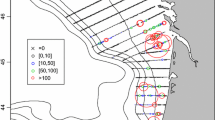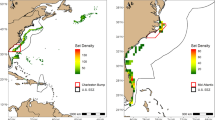Abstract
A methodological approach for modelling the occurrence patterns of species for the purpose of fisheries management is proposed here. The presence/absence of the species is modelled with a hierarchical Bayesian spatial model using the geographical and environmental characteristics of each fishing location. Maps of predicted probabilities of presence are generated using Bayesian kriging. Bayesian inference on the parameters and prediction of presence/absence in new locations (Bayesian kriging) are made by considering the model as a latent Gaussian model, which allows the use of the integrated nested Laplace approximation ( INLA ) software (which has been seen to be quite a bit faster than the well-known MCMC methods). In particular, the spatial effect has been implemented with the stochastic partial differential equation (SPDE) approach. The methodology is evaluated on Mediterranean horse mackerel (Trachurus mediterraneus) in the Western Mediterranean. The analysis shows that environmental and geographical factors can play an important role in directing local distribution and variability in the occurrence of species. Although this approach is used to recognize the habitat of mackerel, it could also be for other different species and life stages in order to improve knowledge of fish populations and communities.







Similar content being viewed by others
References
Abramowitz M, Stegun IA (1972) Handbook of mathematical functions: with formulas, graphs, and mathematical tables, ninth dover printing, tenth gpo printing edn. Dover books on mathematics, Dover
Andrianakis I, Challenor PG (2012) A bayesian hierarchical model for the reconstruction of the sea level in the mediterranean basin for the late 20th century. In: Poster presentation at the ISBA 2012 conference
Banerjee S, Carlin B, Gelfand A (2004) Hierarchical modeling and analysis for spatial data. CRC, London
Busby JR (1991) BIOCLIM: A bioclimatic analysis and predictive system. In: Margules C, Austin M (eds) Nature conservation: cost effective biological surveys and data analysis, CSIRO, Canberra , pp 64–68
Chakraborty A, Gelfand AE, Wilson AM, Latimer AM, Silander JA (2010) Modeling large scale species abundance with latent spatial processes. Ann Appl Stat 4(3):1403–1429
Chien LC, Bangdiwala SI (2012) The implementation of bayesian structural additive regression models in multi-city time series air pollution and human health studies. Stochastic environmental research and risk assessment doi:10.1007/s00477-012-0562-4, in press
Cressie N, Calder CA, Clark JS, Hoef JMV, Wikle CK (2009) Accounting for uncertainty in ecological analysis: The strengths and limitations of hierarchical statistical modeling. Ecol Appl 19:553–5701
Diggle PJ, Ribeiro PJ (2007) Model-based geostatistics. Springer series in statistics, Springer, New York
Diggle PJ, Tawn JA, Moyeed RA (1998) Model-based geostatistics. J R Stat Soc Ser C Appl Stat 47(3):299–350
Fahrmeir L, Tutz G (2001) Multivariate statistical modelling based on generalized linear models, 2nd edn. springer series in statistics, Springer, New Yorkê
Froese R, Pauly D (2011) Fishbase. World Wide Web electronic publication http://www.fishbase.org, version (10/2011)
Gaudard M, Karson M, Linder E, Sinha D (1999) Bayesian spatial prediction. Environ Ecol Stat 35(6):147–171
Gaudard M, Karson M, Linder E, Sinha D (2006) Effects of incorporating spatial autocorrelation into the analysis of species distribution data. Global Ecol Biogeography 16(2):129–138
Geisser S (1993) Predictive inference. monographs on statistics & applied probability, CRC, London
Gelfand AE, Ravishanker N, Ecker MD (2000) Modeling and inference for point-referenced binary spatial data. In: Dey D, Ghosh S, Mallick B (eds) Generalized linear models: a Bayesian perspective, Marcel Dekker Inc., New York, pp 381–394
Gelfand AE, Silander JA, Wu SJ, Latimer AM, Rebelo PLAG, Holder M (2006) Explaining species distribution patterns through hierarchical modeling. Bayesian Anal 1(1):41–92
Gneiting T, Raftery AE (2007) Strictly proper scoring rules, prediction, and estimation. J Am Stat Assoc 102(477):359–378
Guisan A, Thuiller W (2005) Predicting species distribution: offering more than simple habitat models. Ecol Lett 8:993–1009
Guisan A, Edwards TC, Hastie T (2002) Generalized linear and generalized additive models in studies of species distributions: setting the scene. Ecol model 157:89–100
Guttorp P, Gneiting T (2006) Studies in the history of probability and statistics XLIX: On the matérn correlation family. Biometrika 93(4):989–995, http://dx.doi.org/10.1093/biomet/93.4.989
Haining R, Law J, Maheswaran R, Pearson T, Brindley P (2007) Bayesian modelling of environmental risk: a small area ecological study of coronary heart disease mortality in relation to modelled outdoor nitrogen oxide levels. Stochastic Environ Res Risk Assess 21(5):501–509
Handcock MS, Stein ML (1993) A Bayesian analysis of kriging. Technometrics 35(4):403–410
Held L, Schrödle B, Rue H (2010) Posterior and cross-validatory predictive checks: a comparison of MCMC and INLA, Springer, New York
Hijman R, Graham C (2006) The ability of climate envelope models to predict the effect of climate change on species distributions. Global Change Biol 12(12):2272–2281
Hjelle Ø, Dæhlen M (2006) Triangulations and applications. mathematics and visualization, Springer, New York
Hurlbert SH (1984) Pseudoreplication and the design of ecological field experiments. Ecol Monogr 54:187–211
Katara I, Illian J, Graham J, Scott B, Wang J (2008) Atmospheric forcing on chlorophyll concentration in the Mediterranean. Hydrobiologia 612:33–48
Kneib T, Muller J, Hothorn T (2008) Spatial smoothing techniques for the assessment of habitat suitability. Environ Ecol Stat 15(3):343–364
Leathwick JR, Rowe D, Richardson J, Elith J, Hastie T (2005) Using multivariate adaptive regression splines to predict the distributions of New Zealand’s freshwater diadromous fish. Freshwater Biol 50:2034–2052
Lindgren F, Rue H, Lindström J (2011) An explicit link between Gaussian fields and Gaussian Markov random fields: the SPDE approach (with discussion). J R Stat Soc Ser B 73:423–498
Loarie S.R., Carter B.E., Hayhoe K., McMahon S., Moe R., Knight C.A., Ackerly D.D. (2008) Climate change and the future of Californias endemic flora. PLoS ONE 3(6):e2502
Midgley G.F., Thuiller W. (2007) Potential vulnerability of Namaqualand plant diversity to anthropogenic climate change. Journal of Arid Environments 70:615–628
Pressey R.L., Cabeza M., Watts E.M., Cowling R.M., Wilson K.A. (2007) Conservation planning in a changing world. Trends in Ecology and Evolution 22:583–592
R Development Core Team (2010) R: a language and environment for statistical computing. R Foundation for Statistical Computing, Vienna http://www.R-project.org/
Ragonese R, Fiorentino F, Garofalo G, Gristina M, Levi D, Gancitano S, Giusto GB, Rizzo P, Sinacori G (2003) Distribution, abundance and biological features of picarel (Spicara flexuosa), Mediterranean (Trachurus mediterraneus) and Atlantic (T. trachurus) horse mackerel based on experimental bottom-trawl data (MEDITS, 1994–2002) in the Strait of Sicily. MedSudMed Technical Documents 5:100–114
Roos M, Held L (2011) Sensitivity analysis in Bayesian generalized linear mixed models for binary data. Bayesian Anal 6(2):259–278
Royle J.A., Kery M., Gautier R., Schmidt H. (2007) Hierarchical spatial models of abundance and occurrence from imperfect survey data. Ecol Monogr 77:465–481
Rue H, Held L (2005) Gaussian Markov random fields. Theory and applications. CRC, New York
Rue H., Martino S., Chopin N. (2009) Approximate Bayesian inference for latent Gaussian models by using integrated nested Laplace approximations. Journal of the Royal Statistical Society, Series B 71(2):319–392
Schmid CH, Griffith JL (2005) Multivariate classification rules: calibration and discrimination, 2nd edn, Wiley, pp 3491–3497
Schrödle B., Held L. (2011) Spatio-temporal disease mapping using INLA. Environmetrics 22:725–734
Spiegelhalter DJ, Thomas A, Best NG (1999) Winbugs version 1.2 user manual. MRC Biostatistics Unit
Spiegelhalter D.J., Best N., Carlin B., vanderLinde A. (2002) Bayesian measures of model complexity and fit. Journal of the Royal Statistical Society, Series B 64:583–616
Stein ML (1999) Interpolation of spatial data: some theory for Kriging, 1st edn. Springer, New York
Tintore J., Gomis D., Alonso S., Parilla G. (1991) Mesoscale dynamics and vertical motion in the Alboran Sea. Journal of Physical Oceanography 21:811–823
Underwood A.J. (1981) Techniques of analysis of variance in marine Biology and Ecology. Oceanography and Marine Biology Annual Review 19:513–605
Valavanis DV, Katara I, Palialexis A (2004) A GIS-based modelling approach for the mapping of marine productivity hotspots. Aquat Sci 36:234–243
Valavanis D.V., Pierce G.J., Zuur A.F., Palialexis A., Saveliev A., Katara I., Wang J. (2008) Modelling of essential fish habitat based on remote sensing, spatial analysis and GIS. Hydrobiologia 612:5–20
Wisz M.S., Hijmans R.J., Li J., Peterson A.T., Graham C.H., Guisan A. (2008) Effects of sample size on the performance of species distribution models. Divers Distrib 14:763–773
Zhang W. (2007) Supervised neural network recognition of habitat zones of rice invertebrates. Stochastic Environmental Research and Risk Assessment 21(6):729–735
Zhang W., Zhong X., Liu G. (2008) Recognizing spatial distribution patterns of grassland insects: neural network approaches. Stochastic Environmental Research and Risk Assessment 22(2):207–216
Acknowledgements
This paper was mainly written while Maria Grazia Pennino was visiting the department of Statistics and Operations Research at the University of Valencia. David Conesa, Antonio López-Quílez and Facundo Muñoz would like to thank the Ministerio de Educación y Ciencia for financial support (jointly financed with European Regional Development Fund) via the research Grant MTM2010-19528 and of the Generalitat Valenciana via the research Grant ACOMP11/218. We would also like to thank Havard Rue and Finn Lindgren for their prompt support with technical aspects in the usage of INLA .
Author information
Authors and Affiliations
Corresponding author
Rights and permissions
About this article
Cite this article
Muñoz, F., Pennino, M.G., Conesa, D. et al. Estimation and prediction of the spatial occurrence of fish species using Bayesian latent Gaussian models. Stoch Environ Res Risk Assess 27, 1171–1180 (2013). https://doi.org/10.1007/s00477-012-0652-3
Published:
Issue Date:
DOI: https://doi.org/10.1007/s00477-012-0652-3




